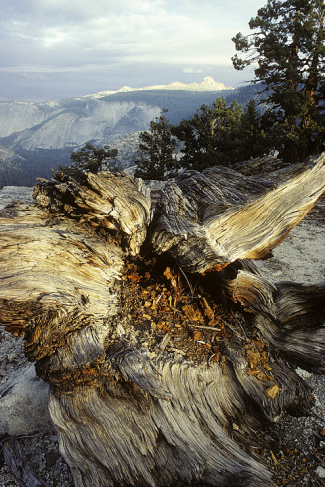Uprooted Juniper Tree on Liberty Cap
click on the image for a larger representation
There came a time very early in my photographic journey when I realized that I was not making photographs the way I should be or could be. My expressions of the Yosemite landscape did not match what I was feeling emotionally when I was standing there and experiencing it in its entire firsthand natural splendor. I would send my exposed Kodachrome slide film off to be developed and wait anxiously for its return thinking that somehow I would receive a minor photographic masterpiece from the fruits of my labor. I was usually fairly disappointed with the results, and wondered why I was not getting back on film what looked and felt so emotionally overwhelming at the moment of exposure.
There were many activities that I was becoming seriously involved in during my first years of living in Yosemite such as rock climbing, nordic skiing, mountaineering, and backpacking. I was reading the writings of adventurer/photographer Galen Rowell and enjoying the photographs that went along with his high and wild stories. These images and stories caused me to feel like I wanted to, at least photographically speaking, be more like Galen Rowell, and less like Walter Flint. Galen Rowell became what he would term, a “phantom mentor”, and he was the first photographer I tried to directly emulate in terms of style and approach.
The earliest book I read by Rowell was “High and Wild” which was a collection of mountaineering adventures along with photographs that documented the story line. This book was hugely influential on me as a photographer. “High and Wild included a story about skiing in the Great Basin National Park in Nevada and contained a photograph titled “Bristlecone Snag under Wheeler Peak” and this photo resonated with me.In an essay about this photograph in his book titled “Mountain Light”, Rowell explained how he had used his 35mm wide angle lens to have the bristlecone tree branch in sharp focus featured prominently in the foreground, but also having the background of Wheeler Peak in relatively sharp focus. I consciously started trying to make these kinds of photographs that had a predominant subject in the foreground but also having some kind secondary subject in the background.
I thought that my photographs needed more depth. I also noticed that my photos suffered from what I call “wide angle disease”. In other words: I tried to put way too much subject matter in my frame and the resulting images said a lot little things about a lot of little things, but didn’t say anything bold or grand about one or two things. I needed to codify my vision and make my photos more about my chosen subject matter, and less about trying to show how many different things I could cram into an image.
I bought a wide angle Nikon 24mm f2.8 lens. My mother had bought me a small aluminum tripod for Christmas in 1986, and with these new pieces of gear, a little newfound knowledge, and a whole lot of newly fueled inspiration, I set out on with a new outlook on the photographic process.
Every backcountry-backpacking trip that I went on included all my camera gear, a tripod, and a cable release. Rowell explained that he treated his 35mm camera like Ansel Adams would treat his giant 4X5 view camera. He would use a tripod and take his time composing his photographs. I started to adapt that approach to my own work and it started paying me dividends almost immediately. Taking the time and effort to use a tripod was the single greatest leap forward in my own photography to date and now I never make a photograph without one.
I was looking around near where I was camped and came across this uprooted Juniper Pine. I was looking at and admiring the texture of the old wood that had weathered so many years at its place in the world. As I was figuring out a way to make an image of it some concentrated, filtered, sunlight broke through clouds to the west and illuminated the contents of the inner part of the stump. This selective light also shone on Mt Clark and made it stand out singularly in the distance. The clouds in the upper left part of the photograph offer a nice counterpoint and fill that space nicely. My previous tendencies would have had me photograph the stump in a way that showed the whole thing. This time I got close to my subject matter and made it prominent in the frame. My 24mm lens was a little more than two-and- a-half feet away from the stump.
This image was made whilst visiting the summit of Liberty Cap in 1988 and is what I consider to be my first truly good photograph, and it was a direct emulation of the bristlecone snag photograph taken by Galen Rowell.
Nikon FM2 film camera
Nikon 24 mm f2.8 lens at f22 hyperfocal distance
Kodachrome 25 ISO slide film


